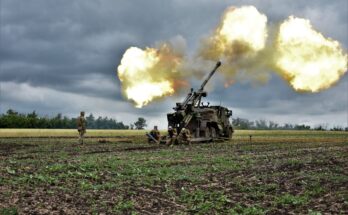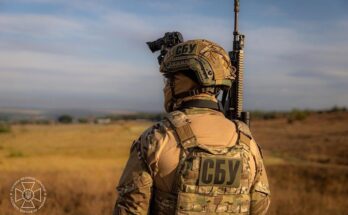
On January 25, the German government announced it would initially transfer 14 Leopard 2 tanks to Ukraine and allow other NATO allies to likewise transfer Leopard 2s to Ukraine. This announcement represented the conclusion of months of wrangling between NATO members over the transfer of high-end main battle tanks to Ukraine.
On the same day, the Biden administration announced it would transfer 31 Abrams main battle tanks to Ukraine in an emergency aid package worth $400 million. The Biden administration claimed Ukraine could expect to receive “hundreds” of tanks. No further details were provided at the time.
Also in January, the British government pledged 14 Challenger 2 tanks for Ukraine.
On April 14, the Canadian defense minister announced Canada has completed delivery of eight Leopard 2A4 tanks to Poland, for transfer to Ukraine.
Ever since these announcements, the whole of the defense-related punditry worldwide has been focused on the technological sophistication of the Leopard 2, M1 Abrams, and Challenger 2 in comparison to the Russian tanks they will face in Ukraine. In doing so, the defense pundits and armchair quarterbacks fall into a trap, missing the more fundamental impact of training and tactics on success in armored warfare on the modern battlefield.
That the Abrams, Challenger 2, and Leopard 2 are technologically superior to their Russian-made counterparts is clearly beyond dispute.
Throughout the 1980s, the U.S. Army expended considerable time, effort, and angst searching for the answer to a singular question: Could the M1 Abrams survive against Soviet main battle tanks in a force-on-force engagement? At the time, the Soviet tank force consisted primarily of T-64, T-72, and T-80 (a gas turbine-powered development of the T-64) main battle tanks. The T-64, T-72, and T-80 share a number of common basic design elements and are equivalent in terms of combat capability and survivability.
In 1991, after a mere 100 hours of ground combat in Iraq, we learned conclusively that not only could the M1A1 Abrams survive, but that the Iraqi T-72s were simply not even in the same league as the Abrams and the British Challenger. During Operation Desert Storm, the Abrams and Challenger proved capable of engaging and destroying T-72s beyond the range of the T-72’s 125mm 2A64M main gun, enabling American and British tank crews to pick off T-72s at long range with impunity. In fact, an FV4034 Challenger achieved a kill at over 5,100 meters (5,577.4 yd, or 3.17 mi), the farthest known tank-versus-tank kill in history.
In close combat, the T-72 fared no better. Abrams and Challenger crews engaged, maneuvered against, and defeated T-72s faster than the Iraqi tank crews could react. During the battle of 73 Easting (February 26, 1991), elements of the U.S. Army’s 2nd Armored Cavalry Regiment, including approximately 36 M1A1 Abrams tanks, defeated two Iraqi armored brigades in close combat. In the battle, the 2nd ACR lost no Abrams tanks and only one M2 Bradley Fighting Vehicle to enemy fire. The Iraqi Army lost 160 tanks, 180 personnel carriers, 12 artillery pieces, and 80 wheeled vehicles.
Clearly, facing an American Abrams or British Challenger in a Russian-made T-72 proved little better than bringing a knife to a gun fight.
Fast forward three decades . . .
The tank force of the Russian Army invading Ukraine consists primarily of T-72, T-80, and T-90 tanks. The T-90 is essentially a late-model T-72 hull and turret, integrating the newer V-84 MS diesel engine and the advanced turret components of the latest T-80U. Open-source reporting indicates tank losses in Ukraine are compelling the Russian Army to retrofit even older T-62 tanks for combat service. With the introduction of Challenger 2s, Leopard 1s, Leopard 2s, and M1A1 Abrams into Ukrainian Army service, Russian Army tank crews in Ukraine may find themselves at an even greater disadvantage.
But technology alone is not the key to modern armored warfare. How these tanks are employed tactically is, and always will be, the key factor. And so, we must look beyond technology to tactical doctrine, training, and employment.
In terms of tactical doctrine and training, the Russian and Ukrainian armies are branches of the same tree, inheritors of the same Soviet Red Army heritage. As such, their common doctrine for tank warfare was shaped by the pioneering tactics of Marshal Georgy Konstantinovich Zhukov. Zhukov’s doctrine employed tank forces as a monolithic mobile sledgehammer – hey, diddle diddle, straight up the middle; amash anything in your way. Russian tank design reflects this tactical philosophy.
Western tank tactical doctrine, on the other hand, is grounded in a cavalry-based philosophy – move fast, strike hard. Don’t give the enemy a chance to effectively react. Where the Russians look to Zhukov for inspiration, the Western armies look to Heinz Guderian, Erwin Rommel, and that most magnificent cavalryman of all, George S. Patton. Western tank design reflects this tactical philosophy, with its emphasis on the speed and maneuverability of the platform, combined with the situational awareness and tactical initiative of the crew.
In Ukraine, if the Leopards, Challengers, and Abrams are employed with crews and commanders well-grounded in Western armored warfare doctrine, the impact on the battlefield will be devastating for Russian forces. But if Ukrainian forces try to employ these Western tanks according to their existing Soviet-style doctrine, the results on the battlefield will be mixed at best, disastrous at worst.
Ukrainian personnel must be trained to operate, maintain, and effectively employ these tanks. That level of training simply does not happen overnight. Even the most sophisticated weapon in the world is utterly useless in untrained (or poorly trained) hands.
Technology does not win battles. Properly trained soldiers win battles. To ignore that enduring reality is to invite disaster and defeat.
Forecast International’s Military Vehicle Forecast provides long-range forecasts on tanks, light tracked and wheeled vehicles, tactical logistics vehicles, and engineering vehicles. The M1 Abrams, Leopard 2, M88A2, M998 Series HMMWV, MRAP, and AAV7/LVTP7 – these are just a sampling of the vehicles featured in this product. An annual subscription includes 81 individual reports, most with a 10-year unit production forecast. Click here to learn more.
Dean is responsible for Military Vehicles Forecast and Ordnance & Munitions Forecast. Prior to joining Forecast International, Dean served as an intelligence analyst in the U.S. Army for 10 years. As an Order of Battle and weapons specialist, he served in a variety of assignments, ranging from running the intelligence section of an Apache attack helicopter squadron in combat to representing a theater-level intelligence organization in a national-level interagency intelligence working group. His intelligence assignments have included duty in Japan, Korea, the Netherlands, Germany, Turkey and Iraq, as well as Fort Hood, Texas, and Norfolk, Virginia.




